CUR-ATE is an interesting program run by LACMA where a museum visit is combined with a unique take on cuisine. This event, hosted on March 11, 2013, revolved thematically around Alexander the Great’s epic conquests across Asia.

The evening began with a brief (one hour) tour by Maite Gomez-Rejón (above) through some of the antiquities galleries. This was fun, but rather lightweight for a series Alexandrite like myself. I’ve always had a thing for the conquerer, particularly given that I was born (reborn?) the night he died (albeit 2293 years later), and succumb myself on occasion to delusions of grandeur.

The menu for the evening, “inspired” by culinary influences along the road Alexander traveled.

We were hosted in LACMA’s Ray’s and Stark Bar and the meal was designed by Executive Chef Kris Morningstar.

Bread, probably far more leavened than the son of Zeus was accustomed too.

Crispy Paneer. Spinch-almond puree, cinnamon scented gold rice, pickled sultanas.
This kind of pan fried fresh cheese is very traditional actually, and particularly paired with a bit of sweet and savory. There are similar dishes in Apicius. It was also delicious.

Rock Cod. Coconut curry, charred lime, cilantro, lentils. Another fabulous dish with an almost Tom Yum Goong vibe to the broth.

An extra, a tandoori charred octopus.

And for a vegetarian, a homemade buccatini with cheese and vegetables.

Lamb Sirloin. Skordhalia, braised artichokes, feta cheese, salsa verde. Also fabulous melding Italian, Middle Eastern, and modern sensibilities.

Spiced Carrot Soup. Pistachio financier, saffron-honey frozen yogurt, candied pistachios, cardamon opaline, pistachio yogurt.
What do you get when you mate carrot cake with bouillabaisse? This dish! And it was fabulous.

Homemade oreos. Hardly Alexandrian, but lovely.
I didn’t have a lot of expectations with regard to this meal but it turned out to be absolutely first rate. The dishes were exciting and memorable with very interesting flavors and excellent execution. Very impressive for a modern riff on exotic and traditional ingredients.
It was a fun evening too, with foodies and history buffs alike!
You can also check out this Roman meal at the Getty based (more authentically) on Apicius.




















